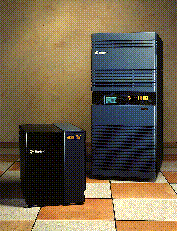SILICON GRAPHICS SUCCESSFULLY COMPUTES LARGEST COMPUTATIONAL
FLUID DYNAMICS PROBLEM
 Company Uses CHALLENGEarray 16/320 Supercomputing Server in
Conjunction with University of Minnesota
Company Uses CHALLENGEarray 16/320 Supercomputing Server in
Conjunction with University of Minnesota
Silicon Graphics, Inc. announced that, on a CHALLENGEarray 16/320
supercomputing server, it has successfully executed the largest
computational fluid dynamics (CFD) problem ever. The company,
working with the University of Minnesota and the Army High
Performance Computing Research Center (AHPCRC), ran the Grand
Challenge class problem during September, 1993.
Silicon Graphics and the Minnesota research team decided to work
together when professor Paul Woodward discovered that he could not
get the desired resolution on the systems at the University of
Minnesota/Army High Performance Computing Research Center, one of
the largest supercomputing facilities in the world. Working with
the Minnesota team, Silicon Graphics put together a parallel
system configuration that had 320 100 MHz MIPS(r) R4400(tm)
processors, 28 Gigabytes of main memory and 192 Gigabytes of disk.
"When we introduced the Challenge(tm) server product line in
January, we claimed we were going to change the supercomputing
paradigm. We configured the CHALLENGEarray, optimized the code and
ran the largest CFD problem ever within five weeks, demonstrating
that we can deliver on our promises," said Forest Baskett, senior
vice president of research and development at Silicon Graphics.
"With the Challenge line, Silicon Graphics will continue to
provide the supercomputing solutions needed for Grand Challenge
problems with cost-effective, general purpose, off-the-shelf
hardware."
 The CFD problem that was computed on the CHALLENGEarray 16/320 was a
compressible turbulence analysis problem that utilized a cube of
10243 mesh. In this particular problem, a cube of fluid is divided
into 1024 cells in each direction resulting in a total of one
billion computational zones. The computational method of domain
decomposition was then applied to the CFD problem and mapped onto
the CHALLENGEarray architecture to facilitate an efficient method
of calculating the problem. The calculation is scientifically
valuable because it will provide greater insight into the
fundamental nature of compressible turbulence.
The CFD problem that was computed on the CHALLENGEarray 16/320 was a
compressible turbulence analysis problem that utilized a cube of
10243 mesh. In this particular problem, a cube of fluid is divided
into 1024 cells in each direction resulting in a total of one
billion computational zones. The computational method of domain
decomposition was then applied to the CFD problem and mapped onto
the CHALLENGEarray architecture to facilitate an efficient method
of calculating the problem. The calculation is scientifically
valuable because it will provide greater insight into the
fundamental nature of compressible turbulence.
"We were very pleased to learn how little reprogramming of our PPM
gas dynamics code was required to extract 4.9 Gigaflops out of a
possible peak performance of 16 Gigaflops from the CHALLENGEarray
16/320," said University of Minnesota professor Paul Woodward. "We
spent two to three weeks tuning our implementation and were
delighted with the result. Our collaboration with Silicon Graphics
allowed us to attack a grand challenge turbulence problem
whose solution had previously seemed beyond the scope of current
computational resources."
To solve this kind of CFD challenge, periodic boundary conditions
were applied in which an identical cube was mathematically placed
on each side, top and bottom of the cube. Data generated from the
calculation can also be used to create hypothetical models of
turbulence that attempt to do calibrations quickly by using a model
rather than solving real equations. The work Woodward and his team
have done in compressible turbulence analysis may be used to be
understand astrophysics, jet engine turbulence or the behavior of a
wake behind a supersonic aircraft.



 The CFD problem that was computed on the CHALLENGEarray 16/320 was a
compressible turbulence analysis problem that utilized a cube of
10243 mesh. In this particular problem, a cube of fluid is divided
into 1024 cells in each direction resulting in a total of one
billion computational zones. The computational method of domain
decomposition was then applied to the CFD problem and mapped onto
the CHALLENGEarray architecture to facilitate an efficient method
of calculating the problem. The calculation is scientifically
valuable because it will provide greater insight into the
fundamental nature of compressible turbulence.
The CFD problem that was computed on the CHALLENGEarray 16/320 was a
compressible turbulence analysis problem that utilized a cube of
10243 mesh. In this particular problem, a cube of fluid is divided
into 1024 cells in each direction resulting in a total of one
billion computational zones. The computational method of domain
decomposition was then applied to the CFD problem and mapped onto
the CHALLENGEarray architecture to facilitate an efficient method
of calculating the problem. The calculation is scientifically
valuable because it will provide greater insight into the
fundamental nature of compressible turbulence.
 Company Uses CHALLENGEarray 16/320 Supercomputing Server in
Conjunction with University of Minnesota
Company Uses CHALLENGEarray 16/320 Supercomputing Server in
Conjunction with University of Minnesota